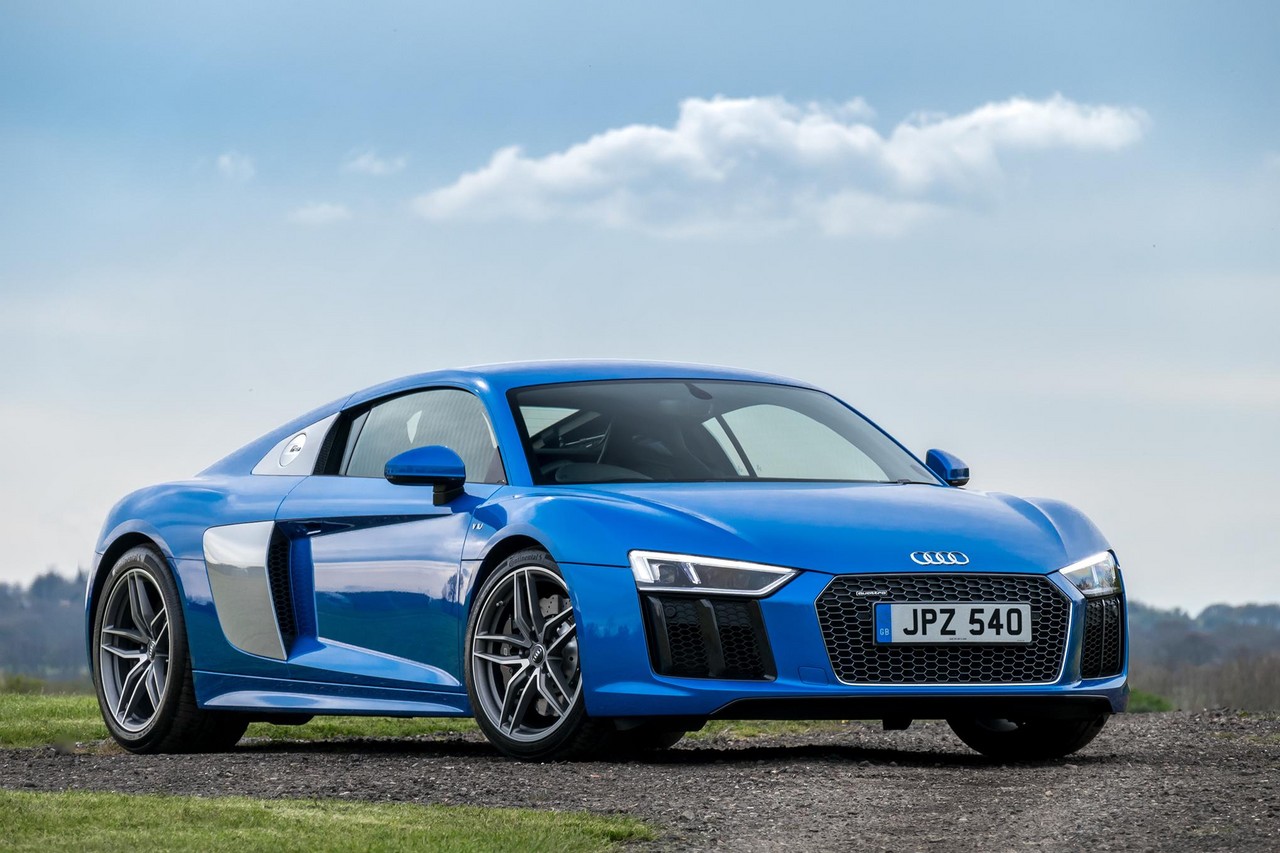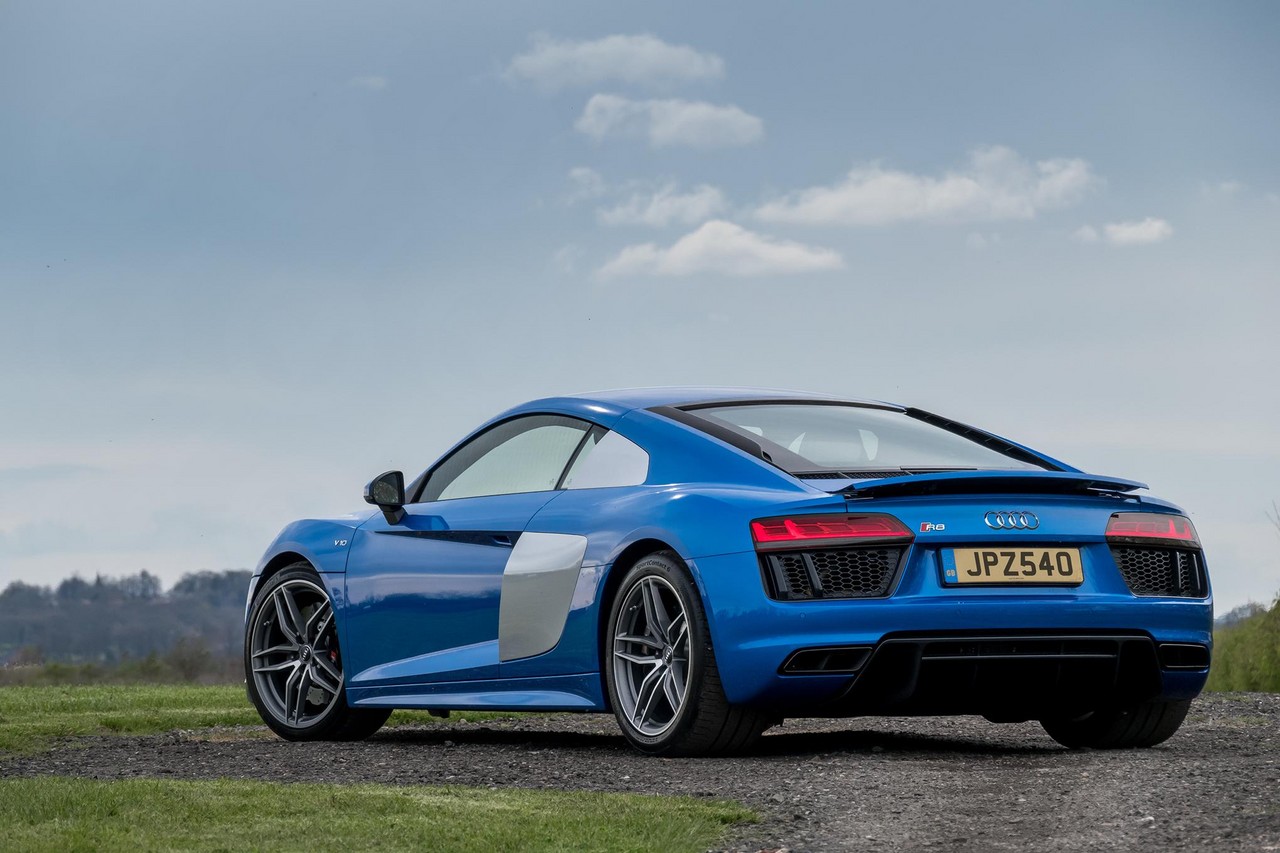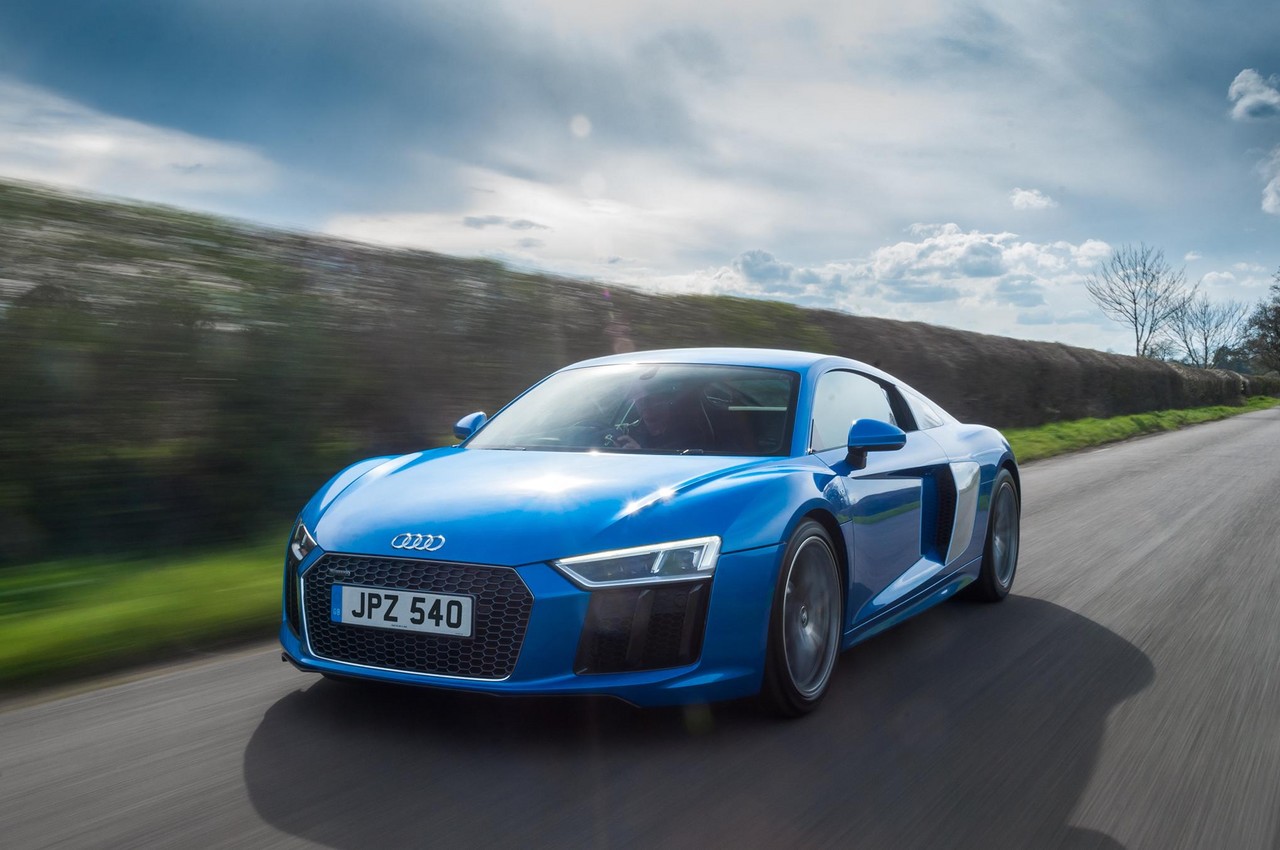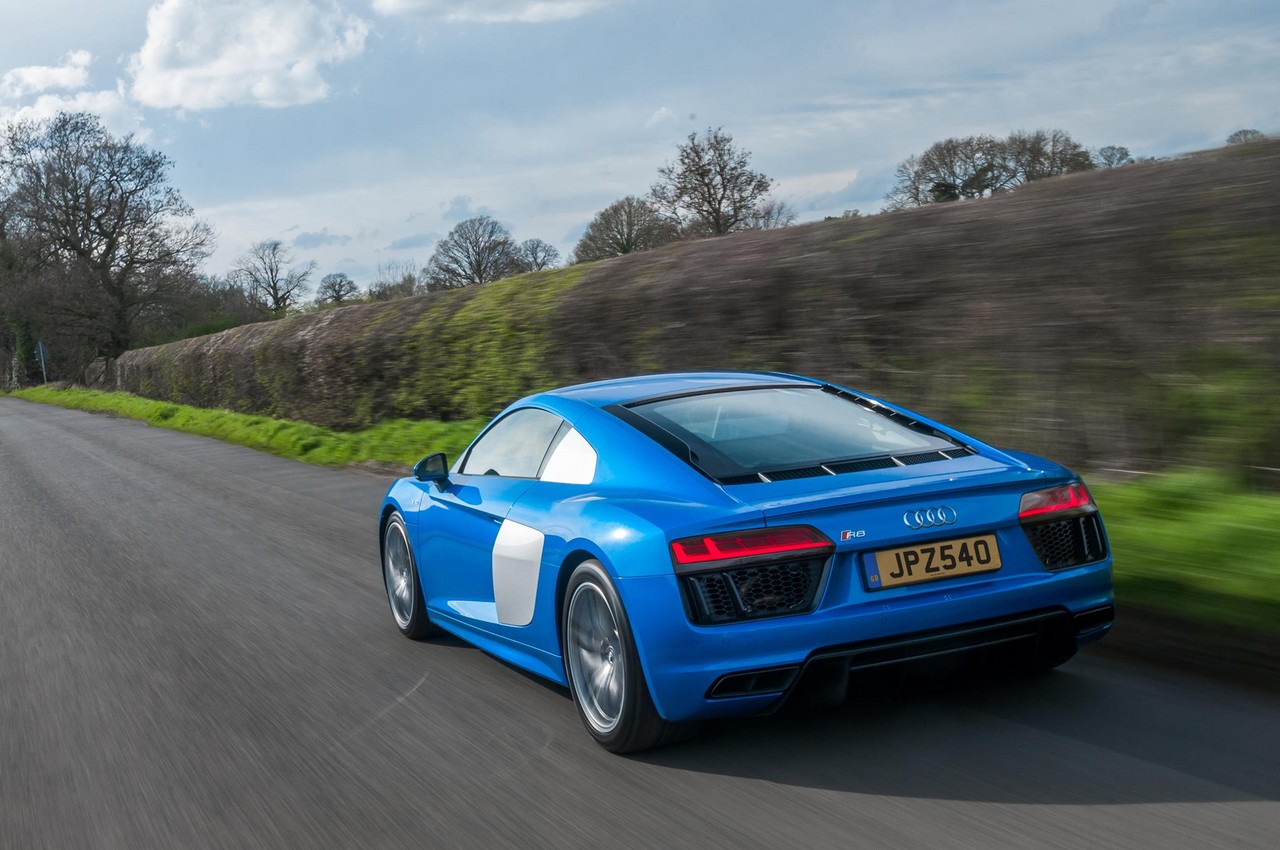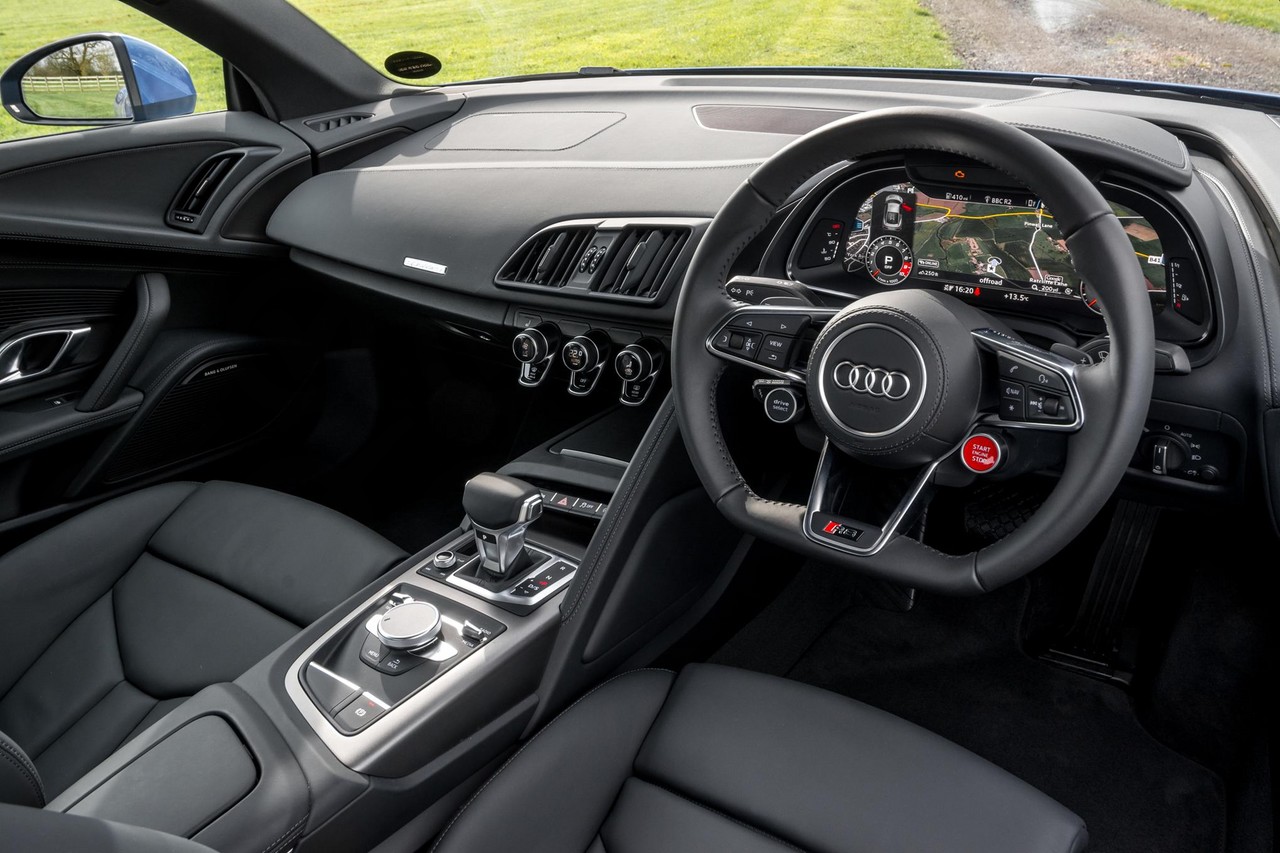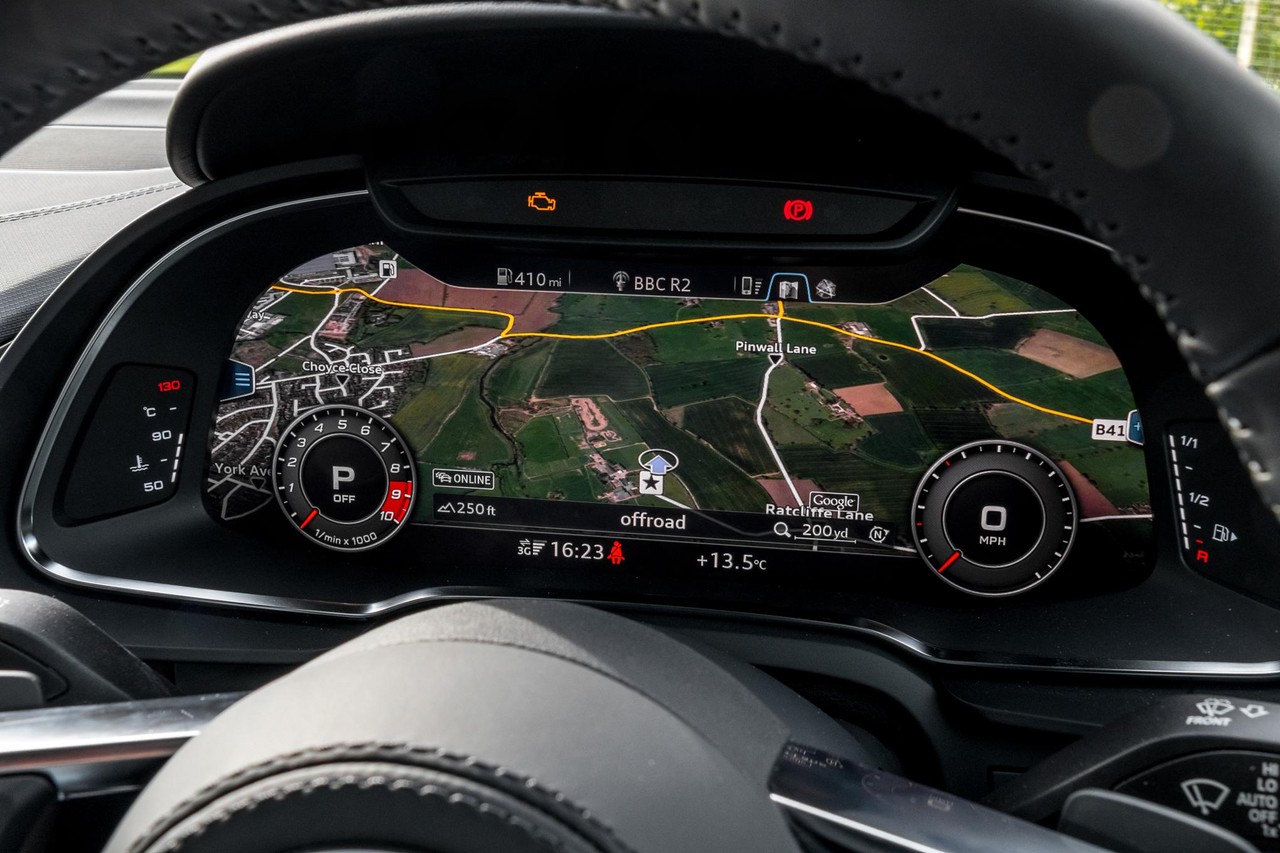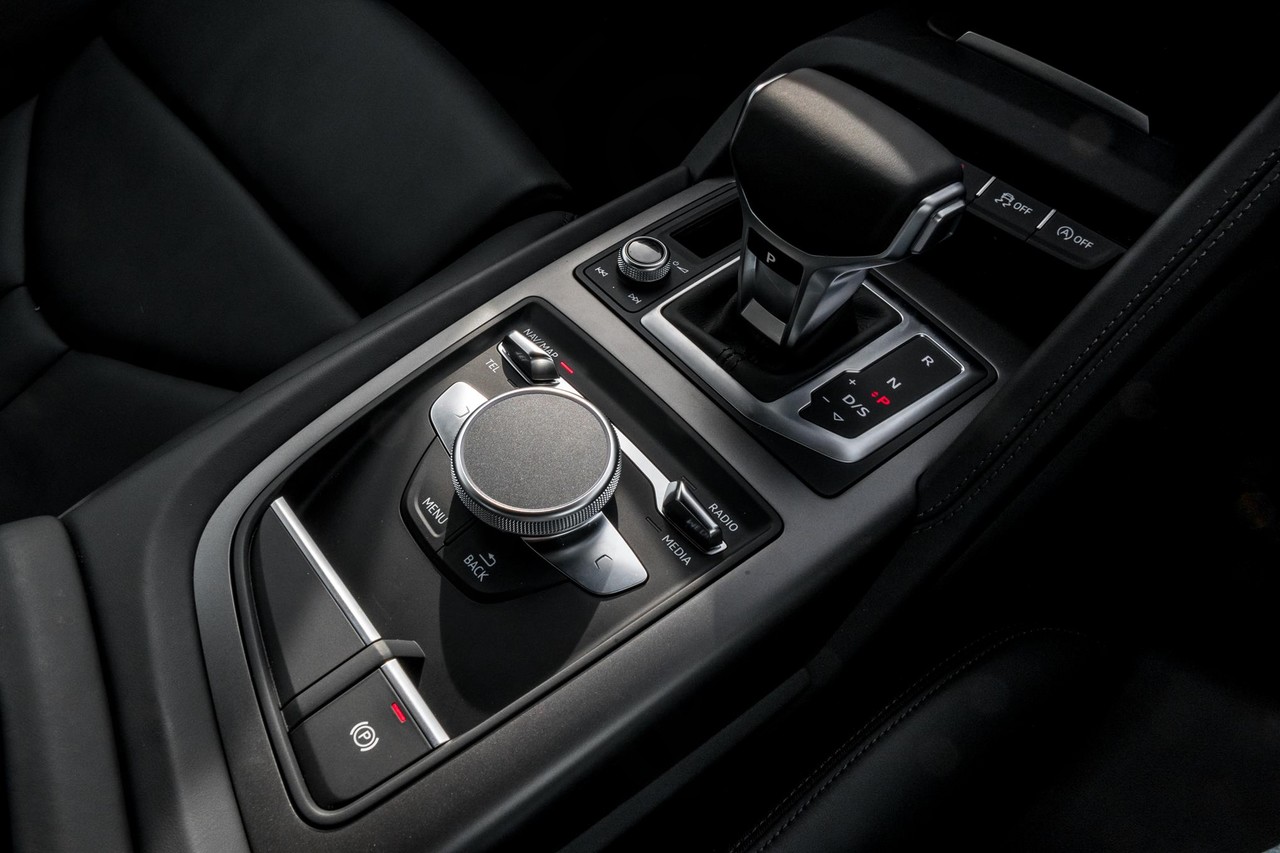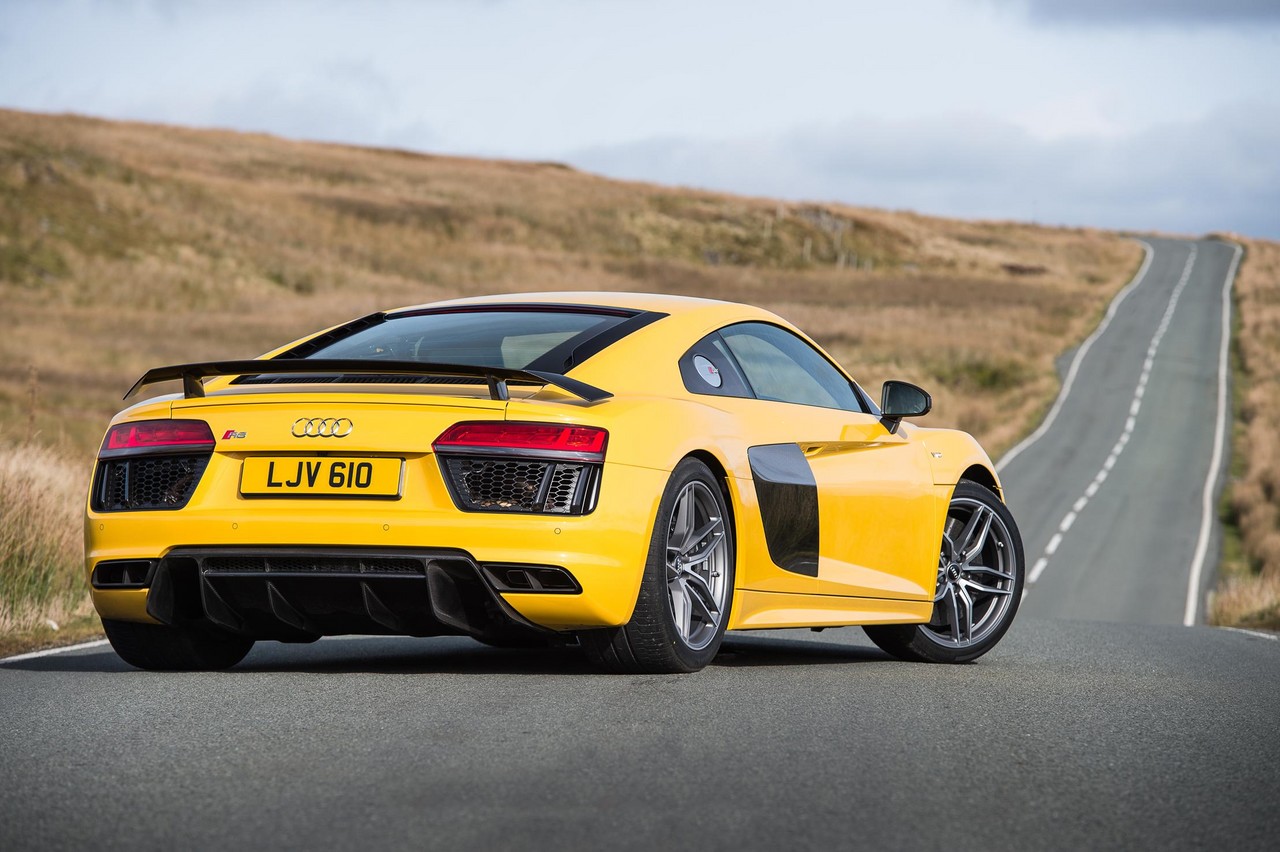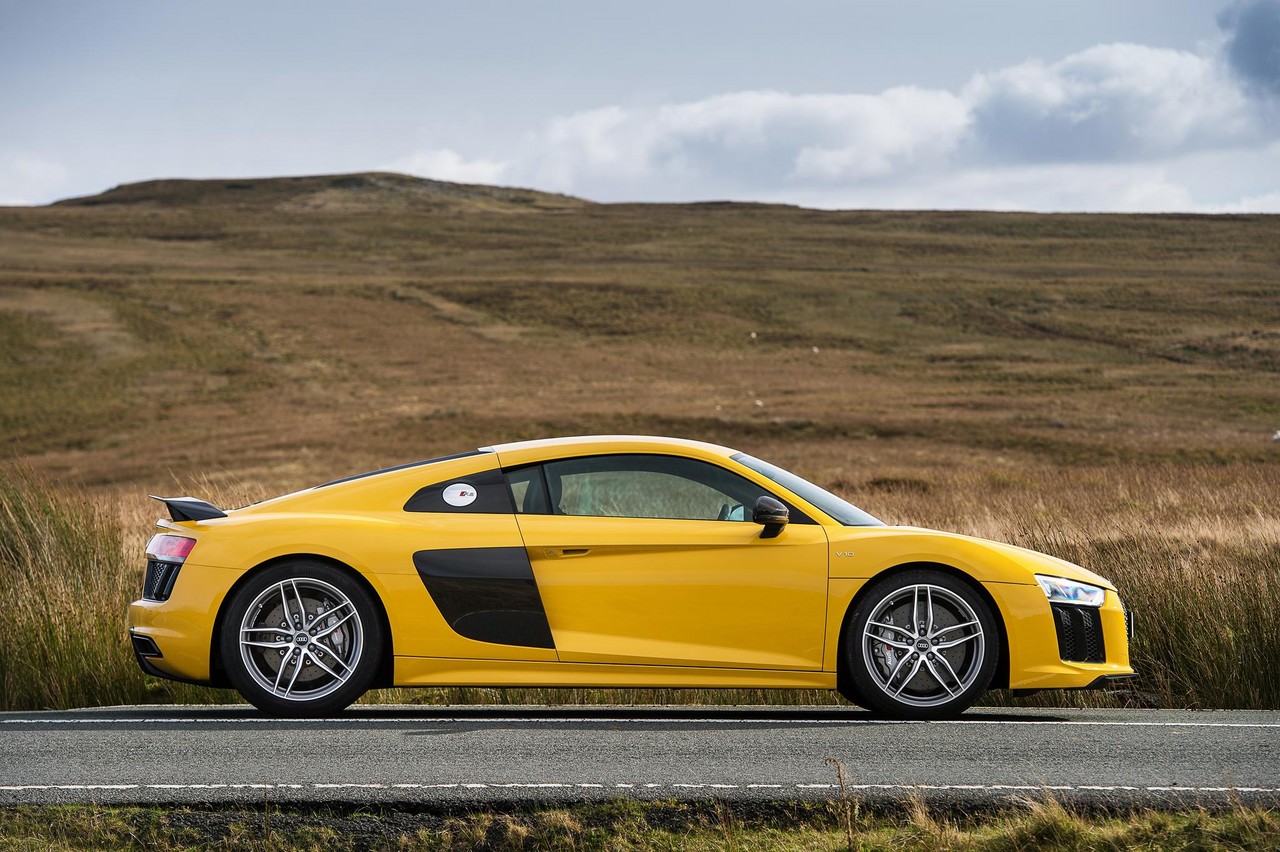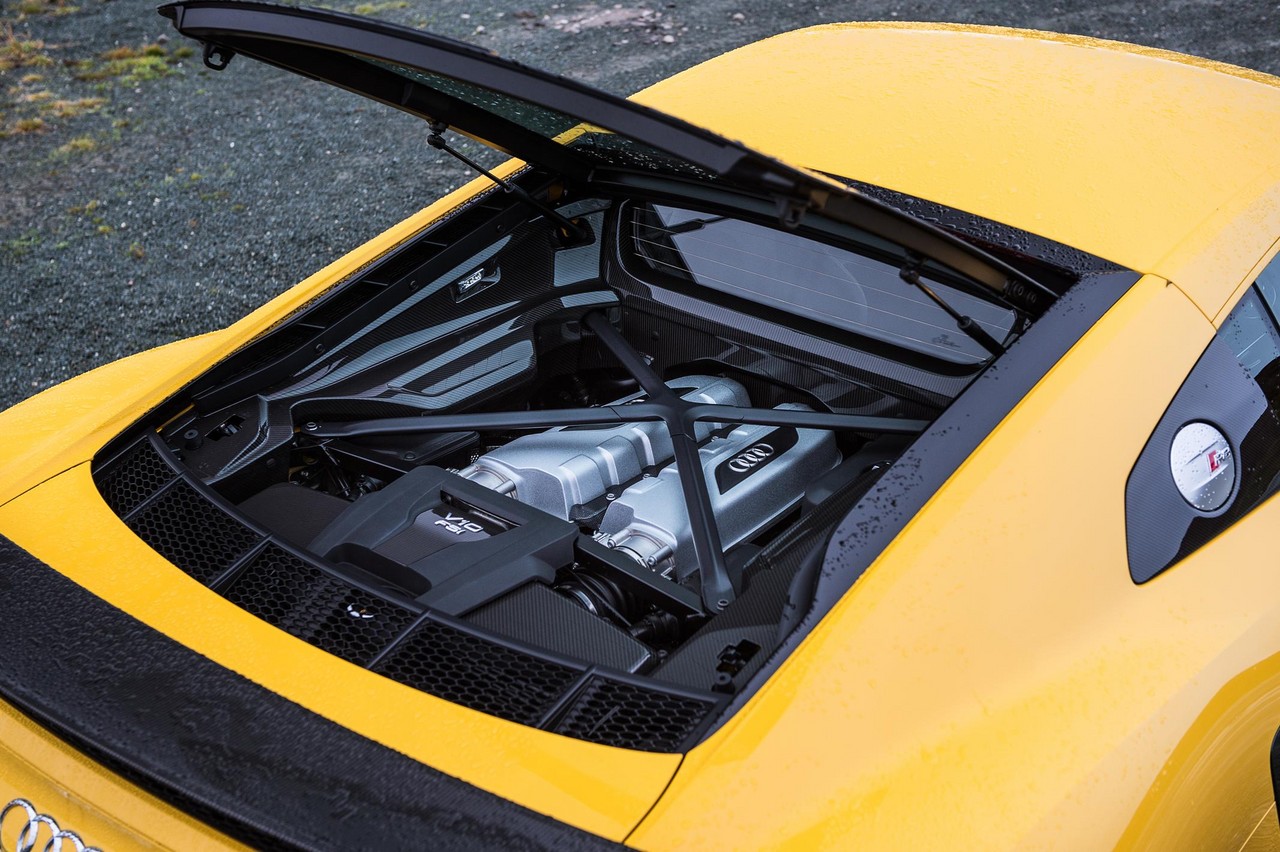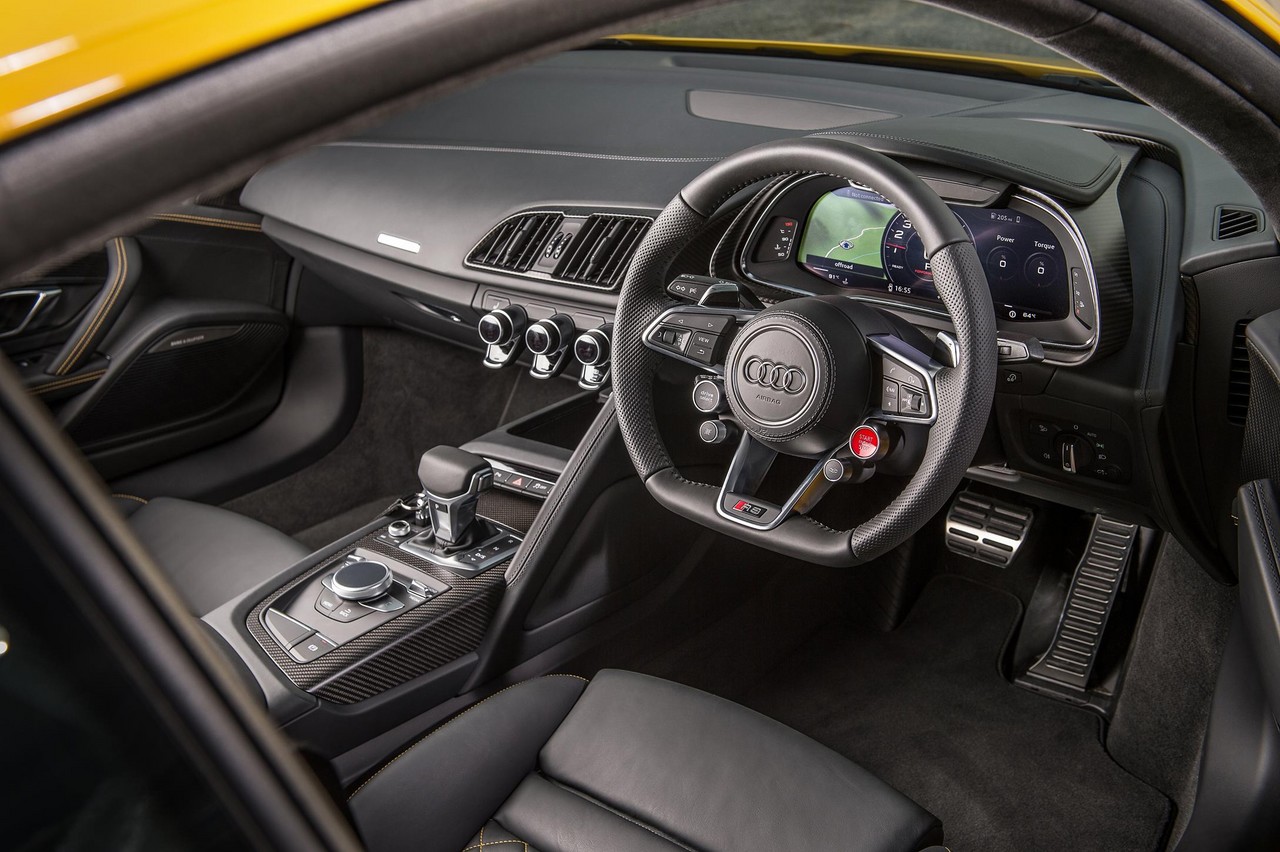
- Free-revving V10 engine
- S-Tronic transmission delivers fast gearshifts
- Traction from quattro system contributes to excellent dynamics
- Accurate, direct steering…
- … but the steering still lacks feedback
- V10 Plus has narrow fixed-back sports seats
- Retail price over $350,000 and no autonmous emergency braking?
Overview
The Audi 4S R8 Coupe commenced production in May 2015 and was officially released in Australia in June 2016. Manufactured at Audi’s newly developed Böllinger Höfe site in Heilbronn, Germany, the all-wheel drive Audi R8 Coupe was offered in V10 and V10 plus editions that were powered by 5.2-litre V10 petrol engines. Upon their release, the Audi R8 Coupe V10 and V10 plus had retail prices of $354,900 and $389,900, respectively (excluding on-road costs).
5.2 FSI: V10 and V10 plus engine
Hand-built at Audi’s Györ plant in Hungary, the Audi R8’s CSP V10 engine had a hypereutectic aluminium-silicon alloy block (AlSi17Cu4Mg) that was reinforced by a cast alloy bedplate (AlSi12Cu1). Furthermore, the CSP V10 engine had a die-forged steel crankshaft which operated on six grey cast iron main bearing caps, cracked trapezoidal connecting rods (36MnVS4), cast aluminium pistons with iron skirts, port-manifold and direct injection (Audi’s ‘Fuel Stratified Injection’ or FSI), a cast aluminium alloy cylinder head, chain-driven double overhead camshafts, four valves per cylinder (with sodium-filled exhaust valves) actuated by roller finger cam followers, variable intake and exhaust valve timing with 42 degrees of adjustment, dry sump lubrication and a compression ratio of 12.7:1.
To minimise fuel consumption, the CSP V10 engine had:
- An ‘automatic Start-Stop’ system which enabled the engine to shut down when the R8 Coupe was stationary in traffic; and,
- Cylinder on demand (COD) technology which enabled the engine to shut down injection and ignition in one of the cylinder banks at low engine loads.
The Audi R8 Coupe V10 could accelerate from rest to 100 km/h in 3.5 seconds and had a top speed of 322 km/h. The Audi R8 Coupe V10 plus, however, was able to accelerate from rest to 100 km/h in 3.2 seconds and had a top speed of 330 km/h. Over the combined ADR 81/02 test cycle, fuel consumption for the R8 Coupe V10 and V10 plus was 11.4 and 12.3 litres per 100 km, respectively.
| Variant | Engine | Trans. | Peak power | Peak torque |
|---|---|---|---|---|
| V10 | 5.2-litre petrol V10 | 7sp DCT | 397 kW at 8000 rpm | 540 Nm at 6500 rpm |
| V10 plus | 5.2-litre petrol V10 | 7sp DCT | 449 kW at 8250 rpm | 560 Nm at 6500 rpm |
‘S tronic’ transmission
The Audi R8 Coupe’s ‘S tronic’ transmission had a three-shaft design which consisted of a dual drive shaft and two output shafts, while two multi-plate clutches operated independent transmission sub-units. Specifically, the K1 clutch transferred torque via a solid shaft to the fixed gear wheels for gears 1, 3, 5 and 7, which were located in the rear section of the transmission housing. Around the solid shaft, there was a hollow shaft that was connected to the second K2 clutch and acted on the gear wheels for gears 2, 4, 6 and reverse. The gear wheels for the reverse, 4, 5 and 1 gears were mounted on output shaft 1, while the gear wheels for gears 2, 6, 3 and 7 were mounted on output shaft 2.
Both transmission sub-units were continually active, but only one was connected to the engine at any one time. According to Audi, gear shifts could be performed in ‘a few hundredths of a second’ to minimise the interruption to propulsive power.
On output shaft 2, the S tronic transmission had a connection to the propeller shaft that extended through the bedplate of the dry sump oil pan to the front axle. An electro-hydraulically activated and electronically controlled multi-plate clutch was mounted there, forming a block with the front differential.
The S tronic transmission had three automatic modes, while sequential gearshifts could be performed via steering wheel gearshift paddles. Innovations for the ‘S tronic’ transmission included:
- A launch control function for full-throttle acceleration from a standing start; and,
- A coasting mode which opened both clutches when the driver lifted their foot from the accelerator pedal and vehicle speed exceeded 55 km/h. Opening the clutches prevented engine braking and therefore had the effect of improving fuel consumption.
quattro and differential lock
In contrast to the 2007 Audi R8 which had a viscous coupling in the front axle housing, the ‘quattro’ all-wheel drive system for the Audi 4S R8 consisted of an electro-hydraulically activated and electronically controlled multi-plate clutch that was integrated with the front differential. According to Audi, the ‘clutch distributes drive torque fully variably according to the driving situation – up to 100 percent can be directed to either the front or rear wheels’. The all-wheel drive system featured ‘active water cooling’ in that it was connected to the engine’s coolant circulation system.
Notwithstanding Audi’s statements, AustralianCar.Reviews expects that the system operates like a Haldex coupling that:
- In normal conditions, directs 90 per cent of the engine’s torque to the rear wheels; and,
- Provides a 50:50 front:rear torque split when the multi-plate clutch engages.
Furthermore, AustralianCar.Reviews suspects that the only way for 100 per cent of ‘drive torque’ to be directed to the front wheels is if the rear wheels have no traction.
For the Audi R8 Coupe V10, the ‘Audi drive select dynamic handling system’ enabled the driver to select from comfort, auto, dynamic and individual drives modes. For the R8 V10 plus, however, additional dry, wet and snow programs were offered in performance mode.
As standard, the Audi R8 Coupe was fitted with a mechanical rear differential lock which provided a 25 per cent locking effect in traction and a 45 per cent locking effect in thrust.
Body and dimensions
The Audi 4S R8 Coupe had a ‘multi-material Audi Space Frame’ which featured a high proportion of aluminium and carbon-fibre reinforced plastic (CFRP). While the front section of the vehicle, the roof arch and the rear section formed a framework that was made from cast aluminium nodes and aluminium profiles, CFRP was used for the B-pillars, central tunnel and rear wall. At 200 kg, the bodyshell was around 15 per cent lighter than that in the 2007 Audi R8 Coupe , yet achieved a 40 per cent increase in torsional rigidity (understood to be 56,000 Nm/degree).
To minimise mass, the outer body panels for the Audi R8 were made from aluminium. For the Audi R8 Coupe V10 plus, however, attachment parts such as the front splitter, rear diffuser and side blades were produced from clear-coated carbon fibre. With an unladen weight of 1555 kg, the Audi R8 Coupe V10 plus was around 50 kg lighter than its predecessor.
Compared to the 2007 Audi R8 Coupe , the Audi 4S R8 Coupe was around 10 mm shorter (at 4420 mm), 35 mm wider (1940 mm) and 12 mm lower (1240 mm), though wheelbase length (2650 mm) was unchanged.
Suspension and ‘Audi magnetic ride’
The Audi 4S R8 Coupe had double wishbone suspension for the front and rear axles which, to conserve mass, was made from aluminium. As standard, the Audi R8 Coupe V10 was fitted with ‘Audi magnetic ride’ shock absorbers which were filled with magnetorheological fluid. With Audi magnetic ride, damper resistance could be varied by the application of a current which created a fibrous structure through the passages of the shock absorber piston and increased the viscosity of the fluid. With Audi magnetic ride, the driver could also select from comfort, auto or dynamic settings.
The Audi R8 Coupe V10 plus, however, was not fitted with Audi magnetic ride and instead had specially tuned sports suspension.
Steering
The Audi 4S R8 Coupe had rack-and-pinion steering with electric power assistance. As an option, the Audi R8 was available with ‘dynamic steering’ which varied the steering ratio – from 10.0:1 to 17.5:1 – according to road speed and the settings selected in the ‘Audi drive select dynamic handling system’.
For the Audi R8 Coupe V10 plus, a fixed 13.0:1 ratio could be selected in the performance programs. At the ‘curve limit’ the dynamic steering system would also counter-steer with ‘tiny impulses to add more stability’.
Safety equipment
Standard safety equipment for the Audi R8 consisted of dual front airbags, front seat-mounted side airbags, front curtain airbags (Audi’s ‘Sideguard’), ABS, electronic brake force distribution, brake assist, electronic stability control, traction control and front seatbelts with pre-tensioners and load limiters.
Brakes
The standard braking package for the Audi R8 Coupe V10 included 365 mm diameter front brake discs with eight-piston fixed brake callipers and 356 mm diameter rear brake discs with four-piston fixed brake callipers.
The Audi R8 Coupe V10 plus, however, had carbon-fibre reinforced ceramic brake discs with a 380 mm front diameter and 356 mm rear diameter.
Features: Audi R8 Coupe V10
Standard features for the Audi R8 Coupe V10 included a 550 watt Bang & Olufsen surround sound system with a sixteen-channel amplifier and thirteen speakers, digital radio tuner (DAB+), Audi’s ‘MMI navigation plus’ with MMI touch, CD/DVD player, an auxiliary-in socket (3.5 mm), Audi Music Interface (two USB ports with charging), two SD card readers, 10GB flash memory, integrated voice control, Bluetooth mobile phone connectivity and audio streaming, and a ‘virtual cockpit’ which consisted of a 12.3-inch digital display in place of the instrument cluster.
Other standard features for the Audi R8 Coupe V10 included 19-inch forged aluminium wheels with 245/35 front and 295/35 R19 rear tyres, Fine Nappa leather upholstery, front sports seats with power adjustment and pneumatic lumbar support, climate control air conditioning, cruise control with speed limiter, LED headlights with auto high-beam, dusk-sensing headlights, rain-sensing wipers, parking sensors (front and rear), a reversing camera, remote central locking with proximity key (i.e. keyless entry), power adjustable door mirrors with folding function and kerb-view function on reverse for the passenger’s side, power windows, a height and reach adjustable steering wheel, auto-dimming rear-view and door mirrors, push-button start, an LED interior lighting package, tyre pressure loss indicator, an alarm and immobiliser.
Features: Audi R8 Coupe V10 plus
The Audi R8 Coupe V10 plus differed in that it had 20-inch forged aluminium wheels in matt titanium look, bucket seats with manual adjustment, Alcantara headlining and an ‘Audi exclusive gloss carbon’ exterior package which consisted of a gloss carbon finish for the front spoiler and rear diffuser insert.
Option: laser headlights
As an extra-cost option, the Audi R8 Coupe was available with ‘laser headlights’ – as first introduced in the Audi R8 V10 LMX in 2014 – which provided a range of 600 metres (twice the range of the LED headlights). For these headlights, each headlight has one laser module which comprises four high-power laser diodes. With a diameter of 300 micrometres, the diodes produced a blue laser beam with a wavelength of 450 nanometres; a phosphor converter then transformed this laser into roadworthy white light with a colour temperature of 5500 Kelvin. The laser spot – active at speeds of 60 km/h and above – supplemented the LED high beams for improved visibility. Furthermore, a camera-based sensor could detect other road users and adjust the light pattern to exclude them.
Specifications
Related links
